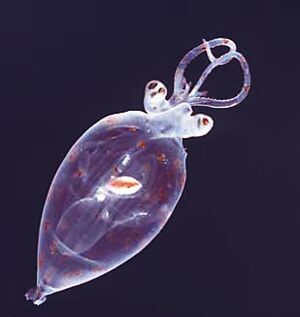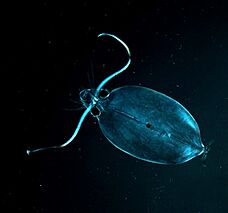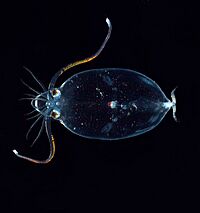Cranchiidae facts for kids
Quick facts for kids Cranchiidae |
|
|---|---|
 |
|
| A young glass squid found near Antarctica | |
| Scientific classification |
|
| Kingdom: | Animalia |
| Phylum: | Mollusca |
| Class: | Cephalopoda |
| Order: | Oegopsida |
| Superfamily: | Cranchioidea |
| Family: | Cranchiidae Prosch, 1847 |
| Subfamilies | |
|
|
| Synonyms | |
|
|
The Cranchiidae family is home to about 60 amazing types of squid, often called glass squid. You might also hear them called cockatoo squid or bathyscaphoid squid. These unique creatures live in the open oceans all around the world, from the surface to deep underwater. They can be quite small, around 10 centimeters (4 inches) long, but some, like the famous colossal squid, can grow to be over 3 meters (10 feet) long!
Their most special feature is their see-through bodies, which is why they're called "glass squid." This transparency helps them hide from predators and prey in the sunlit parts of the ocean.
Contents
What Makes Glass Squid Special?
Glass squid have a round, swollen body and short arms. These arms have two rows of suckers or even hooks! The third pair of arms is often bigger than the others.
How They Hide and Float
Many glass squid can make their own light, a process called bioluminescence. They have special light organs under their eyes. They use these lights to hide their shadows from predators looking up from below. Their eyes can look very different, from large and round to long and stalk-like, like a telescope!
A unique feature of glass squid is how they float. They have a large chamber inside their body filled with a special liquid that contains ammonia. This liquid helps them stay afloat in the water without using much energy. This special floating system is why they are sometimes called "bathyscaphoid squid," because they remind people of a bathyscaphe, which is a type of deep-sea submarine.
Their Inner Workings
Because most glass squid are so clear, you can often see their internal organs. The most visible part is usually a cigar-shaped digestive gland. This gland is like a mammal's liver. It's usually held straight up and down to make its shadow smaller. Sometimes, there's even a light organ on its tip to help it blend in even more.
Life Cycle and Habitat
Like most squid, young glass squid live closer to the ocean surface. As they grow older and mature, they move down into deeper waters. Some types of glass squid can live more than 2 kilometers (1.2 miles) below the sea surface!
It's interesting to note that the body shape of many glass squid changes a lot as they grow. This means that a young glass squid might look so different from an adult that you could easily think they were two different species!
The largest squid in this family is the amazing colossal squid.
Who Named Them?
The Cranchiidae family was named after a naturalist named John Cranch.
Types of Glass Squid
The Cranchiidae family is divided into two main groups, called subfamilies, and includes about 15 different types, or genera:
Cranchiinae Subfamily
- Genus Cranchia
- Genus Leachia
- Genus Liocranchia
Taoniinae Subfamily
- Genus Bathothauma
- Genus Belonella
- Genus Egea
- Genus Galiteuthis
- Genus Helicocranchia
- Genus Liguriella
- Genus Megalocranchia
- Genus Mesonychoteuthis
- Genus Sandalops
- Genus Taonius
- Genus Teuthowenia
- Parateuthis tunicata (incertae sedis)
The genus listed above with an asterisk (*) is still being studied to confirm if it is a separate group or if it belongs with another.



